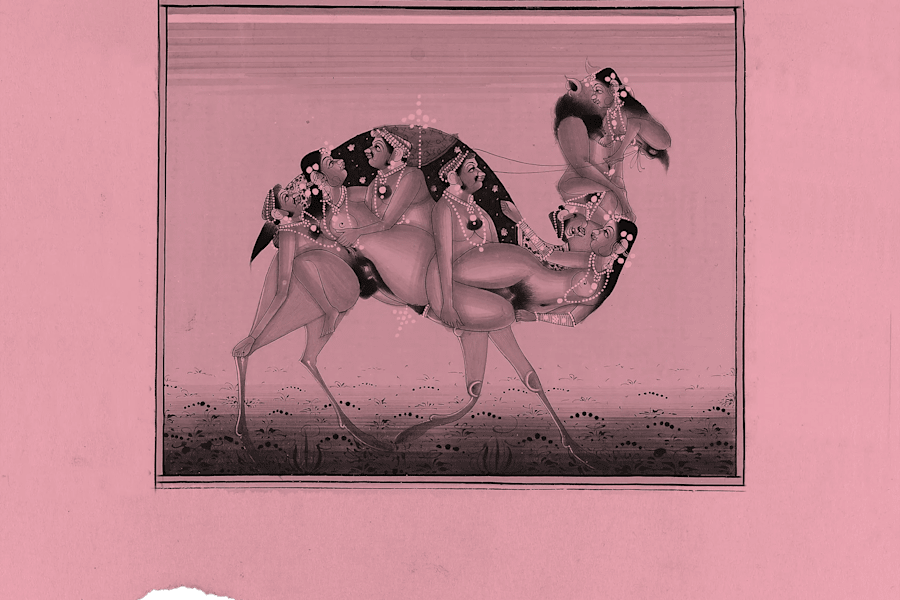
Feeld Guides: navigating the difference between arousal, desire, and attraction.
Did you know that having an erection and desiring sex are entirely separate things? The sensations in your body and the thoughts in your mind are two different parts of getting turned on. Not only that: desiring sex with a specific person is also an entirely separate phenomena.
Usually when someone says something along the lines of “I’m horny!” or “I’m aroused!” or “I want to have sex!” we conflate them to all mean the same thing— that said person is turned on. If we turn our attention to depictions of sex on TV, in movies, or even perfume commercials, nearly all of them conflate desiring sex, having an erection or being wet, and wanting to bang the star on screen to be one thing—one set of feelings and physical changes that all come in a bundle. In truth, these are separate phenomena that sometimes appear together, but oftentimes don’t.
What’s the difference between arousal, desire, and attraction?
“Arousal is the actual physical process of genital engorgement, blood flow, and building towards climax,” explains sexuality educator Aubri Lancaster, in a video on TikTok.
Libido is another term she adds to the mix, which in her words is “basically just the body asking for an orgasm. Just kind of saying ‘hello! I’m here!’”
“And then desire is the wanting,” she says. “That’s the mental process of actually wanting to engage with that libido and wanting to build arousal.”
Sexual attraction, then, “is finding another person sexually appealing and having kind of a hunger for sexual contact with that person specifically,” Lancaster explains.
I’ve personally had many experiences of desire without arousal: I would find myself mentally wanting sex, but not getting wet. Embarrassment was the biggest emotion I felt, but it also came with feeling quite broken. I had learned to believe that desire always appears with lubrication and erections. So with only desire and no physical changes, I thought I had a sexual dysfunction. I went down rabbit holes of research and spent years believing there was something wrong with me.
Lancaster is an AASECT certified sexuality educator with a focus on asexuality and aromanticism. Knowing the difference between these three distinct concepts is, in Lancaster’s words, important because “we need to know the difference between our internal experiences and what society tells us we are supposed to experience,” Lancaster told me in a direct message on Instagram. “When these concepts are conflated, people get medicalized or pathologized for being above or below an arbitrary social metric that may not actually help them understand their internal experiences.”
You can think of it this way: “Food is a popular analogy,” Lancaster wrote. “In this case, arousal would be similar to your stomach growling, desire is wanting to eat, and attraction is what food you find appealing or appetizing. You can eat when you’re not hungry, you can be hungry and not want to eat, and you can be hungry and want to eat, but may not find any food to be particularly appealing,” she says.
With this analogy, the distinctions become a little better defined. You can have sex when you’re not physically aroused, you can be aroused and not want to have sex, and you can be aroused, want to have sex/an orgasm, but you don’t find a particular person appealing to have sex with, or you don't feel attracted to anyone.
To get even more specific, sexual attraction is the directionality of arousal and libido, says Lancaster. It’s who, if anyone, that arousal, libido, or wanting is directed at. And asexual people—people who experience little to no sexual attraction—are often one of the groups of people who are pathologized when arousal, desire, and attraction are lumped together as one.
Even medical providers, therapists, sex educators, and coaches may unknowingly dismiss asexuality as “low libido” and try to “boost” libido because there is a lack of understanding of the differences between the three concepts. Not just that, but many people personally struggle to understand their identities when they don’t have the language to understand each of these experiences (Hi! It’s me, still learning who I am and how my body works!).
It’s also very common to see people who have challenges getting or maintaining an erection or lubrication to feel pathologized. While it’s very valid to seek support for these issues, understanding that someone can have desire without arousal can help normalize their experience, and understanding that bodies simply don't always produce erections and lubrication while always expecting them to is unrealistic.
Beyond that, knowing how desire and arousal might not always appear together can help people build tools for enjoying and finding physical pleasure even when arousal isn’t present.
Perhaps one of the most important elements of understanding the difference between arousal and desire is that it confirms how important it is to communicate beyond just body language. While we’ve learned to assume that erections and lubrication are a sign someone is enjoying themselves, knowing that you can be aroused without wanting sex proves just how untrue this is, and how important it is to communicate beyond looking for signs of arousal.
For me, understanding the difference between attraction, desire, and arousal has helped me know my body so much better. Before learning about each, I didn’t know what libido, desire, and attraction actually felt like in my body. I now know that wanting an orgasm doesn’t necessarily mean I want to have sex with someone else, or that I can enjoy an entire sexual experience without ever getting aroused. Knowing what sexual attraction actually is has helped me understand my sexual orientation.
Learning the difference between arousal, desire, attraction, and libido can take time, and the goal is not memorizing definitions. Instead, understanding the difference between each of these phenomena is intended to give you accurate information to help you understand your own interiority, and all kinds of experiences.
Related Articles

Come, let us drool together.
That shared moment of communal lust in the group chat is a precious thing. Aaron Ewards tell us why.

How deep can a kiss go?
Two psychoanalysts discuss confronting the contemporary abyss of intimacy.
